3803NRS: Failure to Rescue in Acute Healthcare Essay
VerifiedAdded on 2023/04/25
|13
|3607
|205
Essay
AI Summary
This essay critically evaluates the concept of 'failure to rescue' in the context of acute healthcare, focusing on the deteriorating patient. It begins with a definition of failure to rescue and examines its incidence and consequences, including impacts on patients, their families, and the healthcare system, referencing statistics on adverse events in Australian hospitals. The essay then discusses environmental and educational barriers faced by nurses in preventing failure to rescue, such as low nurse-to-patient ratios and insufficient training. It explores strategies to overcome these barriers, including simulation-based training and continuous vital sign surveillance systems. The essay also highlights nursing strategies like clinical autonomy and interprofessional practice to enhance patient safety, emphasizing the importance of nursing knowledge and teamwork in improving patient outcomes. The analysis is underpinned by a focus on patient safety and includes interprofessional practice to prevent adverse events.
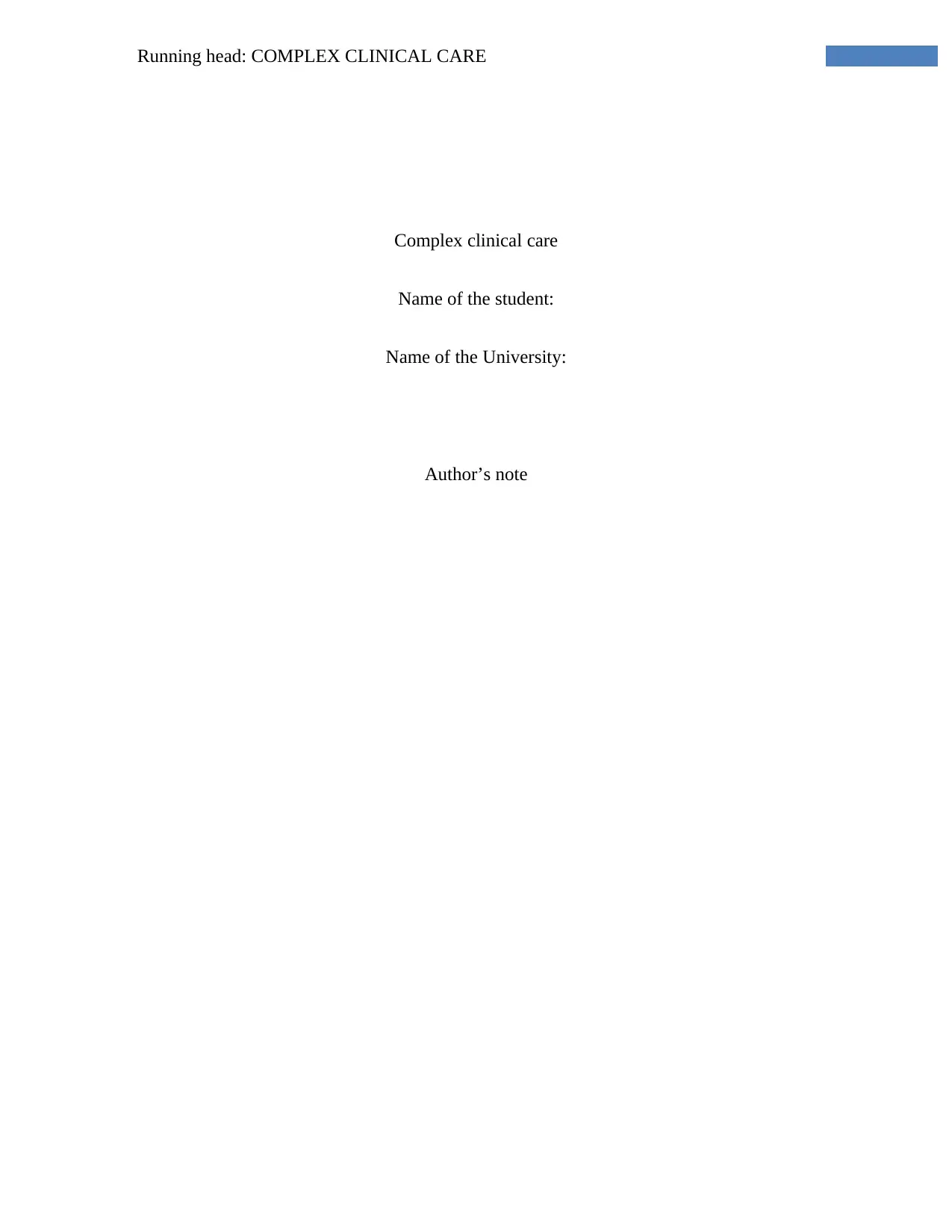
Running head: COMPLEX CLINICAL CARE
Complex clinical care
Name of the student:
Name of the University:
Author’s note
Complex clinical care
Name of the student:
Name of the University:
Author’s note
Paraphrase This Document
Need a fresh take? Get an instant paraphrase of this document with our AI Paraphraser
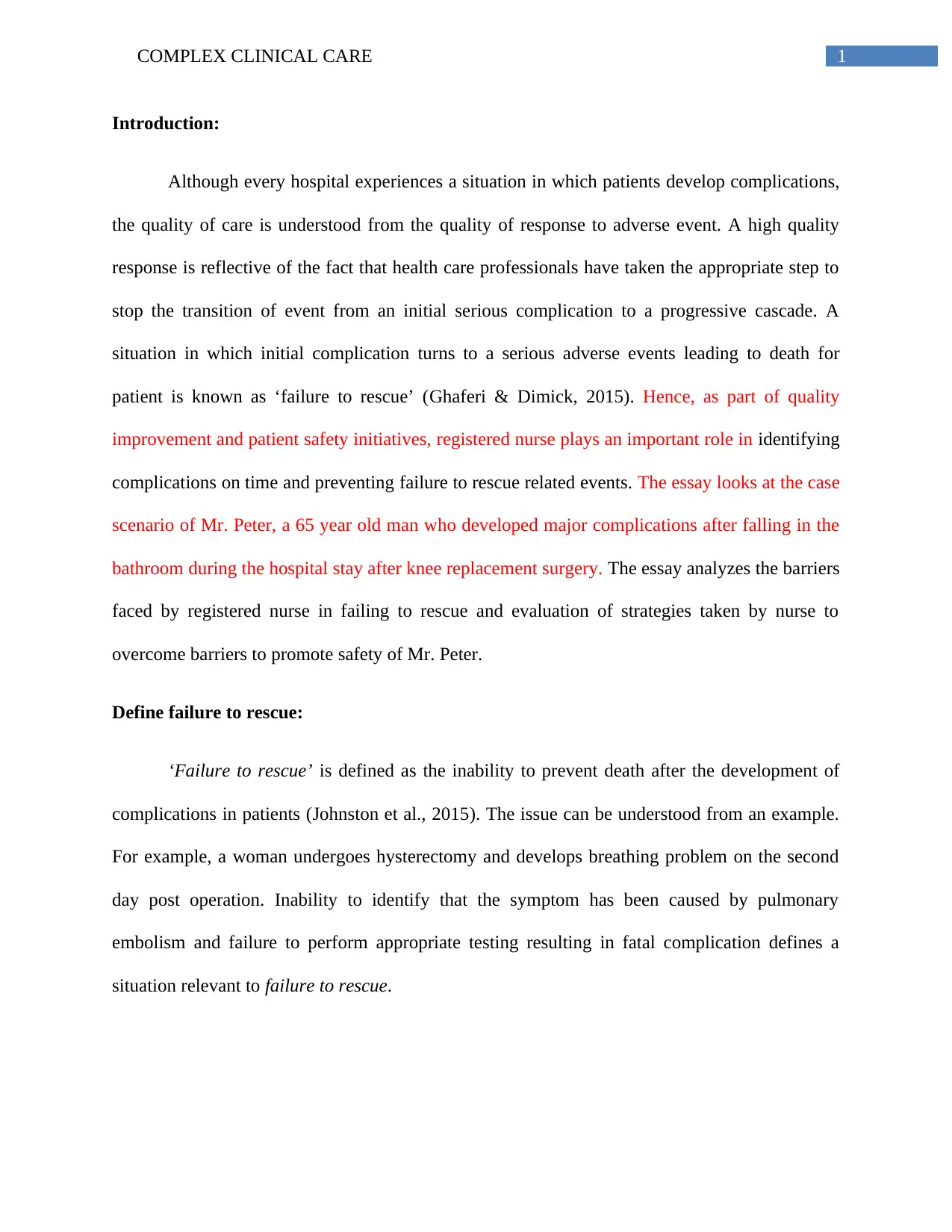
1COMPLEX CLINICAL CARE
Introduction:
Although every hospital experiences a situation in which patients develop complications,
the quality of care is understood from the quality of response to adverse event. A high quality
response is reflective of the fact that health care professionals have taken the appropriate step to
stop the transition of event from an initial serious complication to a progressive cascade. A
situation in which initial complication turns to a serious adverse events leading to death for
patient is known as ‘failure to rescue’ (Ghaferi & Dimick, 2015). Hence, as part of quality
improvement and patient safety initiatives, registered nurse plays an important role in identifying
complications on time and preventing failure to rescue related events. The essay looks at the case
scenario of Mr. Peter, a 65 year old man who developed major complications after falling in the
bathroom during the hospital stay after knee replacement surgery. The essay analyzes the barriers
faced by registered nurse in failing to rescue and evaluation of strategies taken by nurse to
overcome barriers to promote safety of Mr. Peter.
Define failure to rescue:
‘Failure to rescue’ is defined as the inability to prevent death after the development of
complications in patients (Johnston et al., 2015). The issue can be understood from an example.
For example, a woman undergoes hysterectomy and develops breathing problem on the second
day post operation. Inability to identify that the symptom has been caused by pulmonary
embolism and failure to perform appropriate testing resulting in fatal complication defines a
situation relevant to failure to rescue.
Introduction:
Although every hospital experiences a situation in which patients develop complications,
the quality of care is understood from the quality of response to adverse event. A high quality
response is reflective of the fact that health care professionals have taken the appropriate step to
stop the transition of event from an initial serious complication to a progressive cascade. A
situation in which initial complication turns to a serious adverse events leading to death for
patient is known as ‘failure to rescue’ (Ghaferi & Dimick, 2015). Hence, as part of quality
improvement and patient safety initiatives, registered nurse plays an important role in identifying
complications on time and preventing failure to rescue related events. The essay looks at the case
scenario of Mr. Peter, a 65 year old man who developed major complications after falling in the
bathroom during the hospital stay after knee replacement surgery. The essay analyzes the barriers
faced by registered nurse in failing to rescue and evaluation of strategies taken by nurse to
overcome barriers to promote safety of Mr. Peter.
Define failure to rescue:
‘Failure to rescue’ is defined as the inability to prevent death after the development of
complications in patients (Johnston et al., 2015). The issue can be understood from an example.
For example, a woman undergoes hysterectomy and develops breathing problem on the second
day post operation. Inability to identify that the symptom has been caused by pulmonary
embolism and failure to perform appropriate testing resulting in fatal complication defines a
situation relevant to failure to rescue.
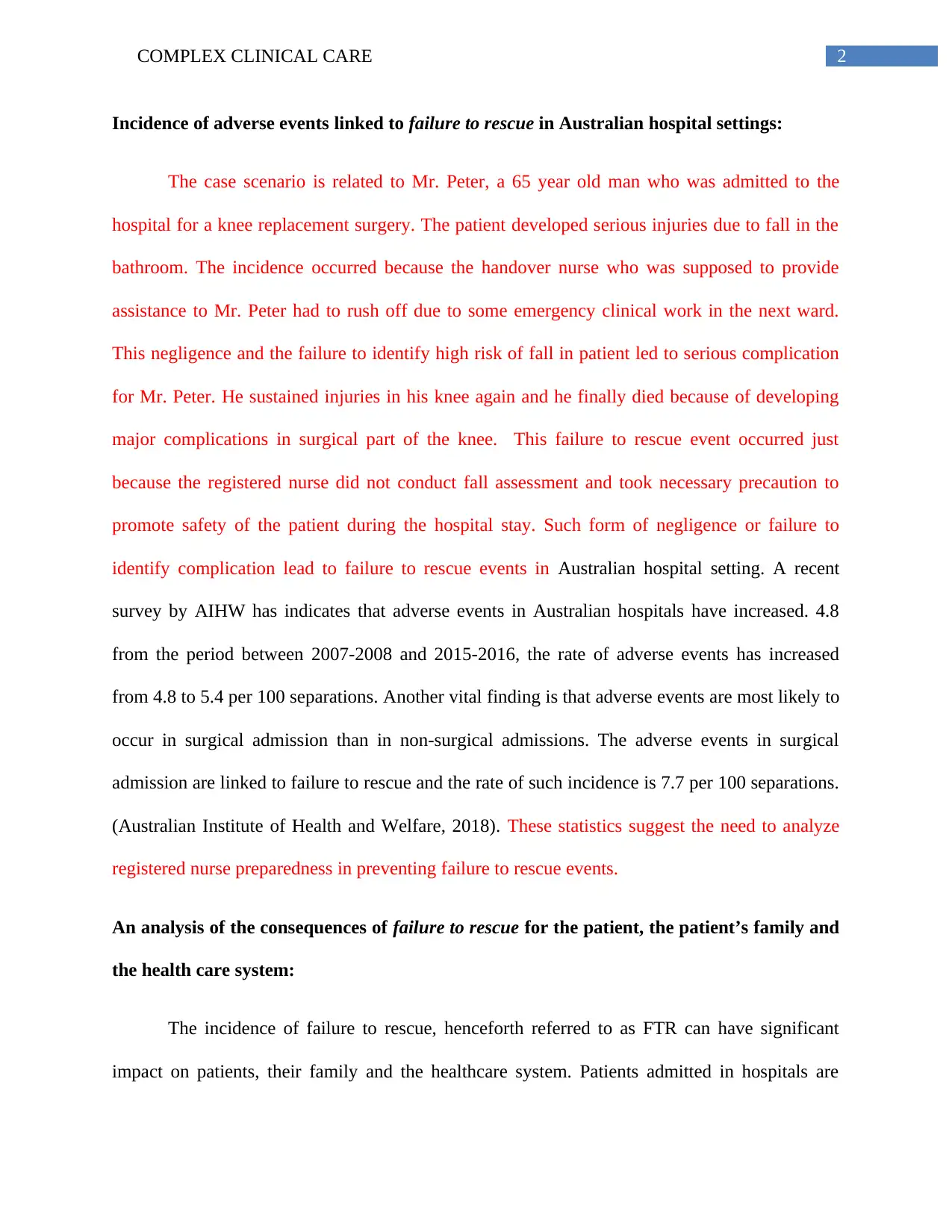
2COMPLEX CLINICAL CARE
Incidence of adverse events linked to failure to rescue in Australian hospital settings:
The case scenario is related to Mr. Peter, a 65 year old man who was admitted to the
hospital for a knee replacement surgery. The patient developed serious injuries due to fall in the
bathroom. The incidence occurred because the handover nurse who was supposed to provide
assistance to Mr. Peter had to rush off due to some emergency clinical work in the next ward.
This negligence and the failure to identify high risk of fall in patient led to serious complication
for Mr. Peter. He sustained injuries in his knee again and he finally died because of developing
major complications in surgical part of the knee. This failure to rescue event occurred just
because the registered nurse did not conduct fall assessment and took necessary precaution to
promote safety of the patient during the hospital stay. Such form of negligence or failure to
identify complication lead to failure to rescue events in Australian hospital setting. A recent
survey by AIHW has indicates that adverse events in Australian hospitals have increased. 4.8
from the period between 2007-2008 and 2015-2016, the rate of adverse events has increased
from 4.8 to 5.4 per 100 separations. Another vital finding is that adverse events are most likely to
occur in surgical admission than in non-surgical admissions. The adverse events in surgical
admission are linked to failure to rescue and the rate of such incidence is 7.7 per 100 separations.
(Australian Institute of Health and Welfare, 2018). These statistics suggest the need to analyze
registered nurse preparedness in preventing failure to rescue events.
An analysis of the consequences of failure to rescue for the patient, the patient’s family and
the health care system:
The incidence of failure to rescue, henceforth referred to as FTR can have significant
impact on patients, their family and the healthcare system. Patients admitted in hospitals are
Incidence of adverse events linked to failure to rescue in Australian hospital settings:
The case scenario is related to Mr. Peter, a 65 year old man who was admitted to the
hospital for a knee replacement surgery. The patient developed serious injuries due to fall in the
bathroom. The incidence occurred because the handover nurse who was supposed to provide
assistance to Mr. Peter had to rush off due to some emergency clinical work in the next ward.
This negligence and the failure to identify high risk of fall in patient led to serious complication
for Mr. Peter. He sustained injuries in his knee again and he finally died because of developing
major complications in surgical part of the knee. This failure to rescue event occurred just
because the registered nurse did not conduct fall assessment and took necessary precaution to
promote safety of the patient during the hospital stay. Such form of negligence or failure to
identify complication lead to failure to rescue events in Australian hospital setting. A recent
survey by AIHW has indicates that adverse events in Australian hospitals have increased. 4.8
from the period between 2007-2008 and 2015-2016, the rate of adverse events has increased
from 4.8 to 5.4 per 100 separations. Another vital finding is that adverse events are most likely to
occur in surgical admission than in non-surgical admissions. The adverse events in surgical
admission are linked to failure to rescue and the rate of such incidence is 7.7 per 100 separations.
(Australian Institute of Health and Welfare, 2018). These statistics suggest the need to analyze
registered nurse preparedness in preventing failure to rescue events.
An analysis of the consequences of failure to rescue for the patient, the patient’s family and
the health care system:
The incidence of failure to rescue, henceforth referred to as FTR can have significant
impact on patients, their family and the healthcare system. Patients admitted in hospitals are
⊘ This is a preview!⊘
Do you want full access?
Subscribe today to unlock all pages.

Trusted by 1+ million students worldwide
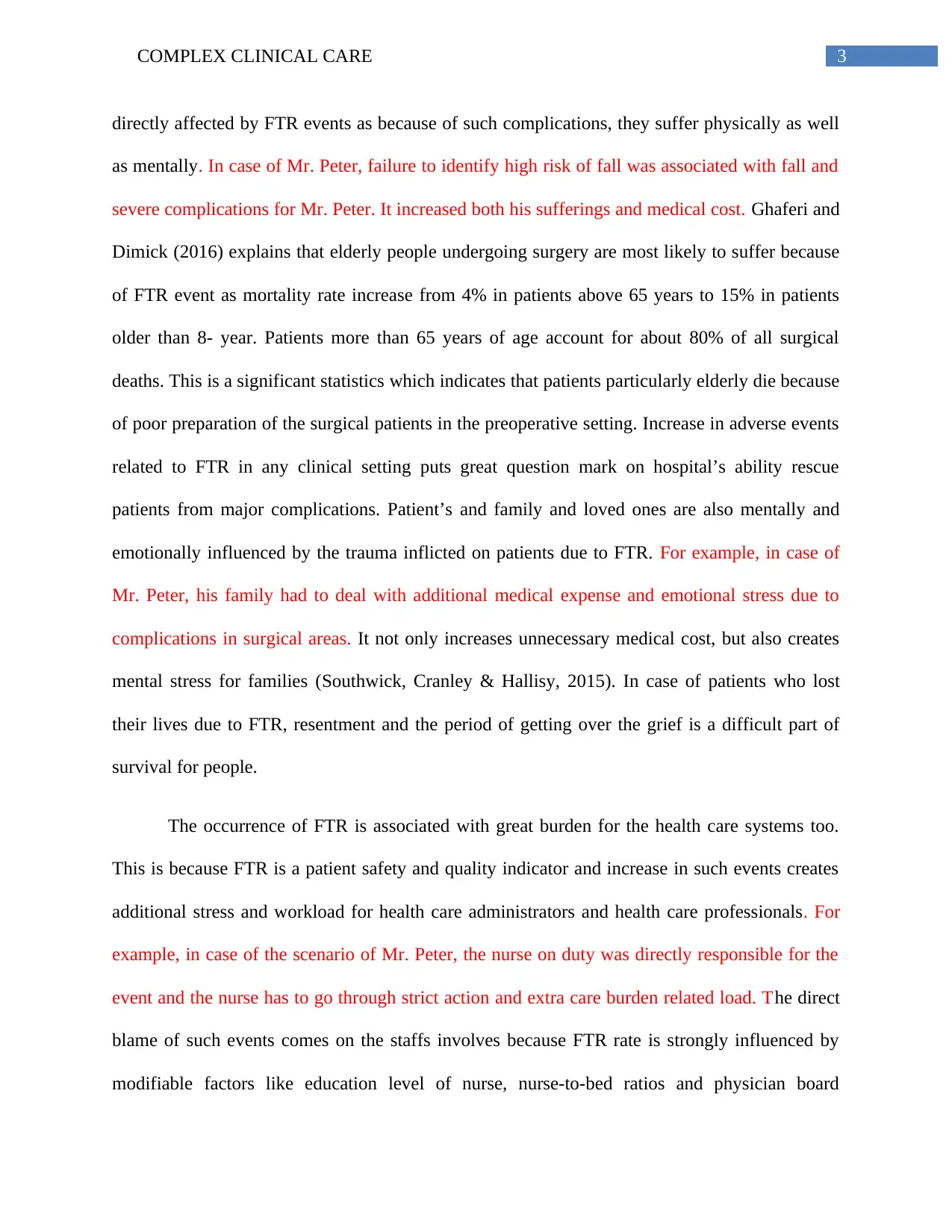
3COMPLEX CLINICAL CARE
directly affected by FTR events as because of such complications, they suffer physically as well
as mentally. In case of Mr. Peter, failure to identify high risk of fall was associated with fall and
severe complications for Mr. Peter. It increased both his sufferings and medical cost. Ghaferi and
Dimick (2016) explains that elderly people undergoing surgery are most likely to suffer because
of FTR event as mortality rate increase from 4% in patients above 65 years to 15% in patients
older than 8- year. Patients more than 65 years of age account for about 80% of all surgical
deaths. This is a significant statistics which indicates that patients particularly elderly die because
of poor preparation of the surgical patients in the preoperative setting. Increase in adverse events
related to FTR in any clinical setting puts great question mark on hospital’s ability rescue
patients from major complications. Patient’s and family and loved ones are also mentally and
emotionally influenced by the trauma inflicted on patients due to FTR. For example, in case of
Mr. Peter, his family had to deal with additional medical expense and emotional stress due to
complications in surgical areas. It not only increases unnecessary medical cost, but also creates
mental stress for families (Southwick, Cranley & Hallisy, 2015). In case of patients who lost
their lives due to FTR, resentment and the period of getting over the grief is a difficult part of
survival for people.
The occurrence of FTR is associated with great burden for the health care systems too.
This is because FTR is a patient safety and quality indicator and increase in such events creates
additional stress and workload for health care administrators and health care professionals. For
example, in case of the scenario of Mr. Peter, the nurse on duty was directly responsible for the
event and the nurse has to go through strict action and extra care burden related load. The direct
blame of such events comes on the staffs involves because FTR rate is strongly influenced by
modifiable factors like education level of nurse, nurse-to-bed ratios and physician board
directly affected by FTR events as because of such complications, they suffer physically as well
as mentally. In case of Mr. Peter, failure to identify high risk of fall was associated with fall and
severe complications for Mr. Peter. It increased both his sufferings and medical cost. Ghaferi and
Dimick (2016) explains that elderly people undergoing surgery are most likely to suffer because
of FTR event as mortality rate increase from 4% in patients above 65 years to 15% in patients
older than 8- year. Patients more than 65 years of age account for about 80% of all surgical
deaths. This is a significant statistics which indicates that patients particularly elderly die because
of poor preparation of the surgical patients in the preoperative setting. Increase in adverse events
related to FTR in any clinical setting puts great question mark on hospital’s ability rescue
patients from major complications. Patient’s and family and loved ones are also mentally and
emotionally influenced by the trauma inflicted on patients due to FTR. For example, in case of
Mr. Peter, his family had to deal with additional medical expense and emotional stress due to
complications in surgical areas. It not only increases unnecessary medical cost, but also creates
mental stress for families (Southwick, Cranley & Hallisy, 2015). In case of patients who lost
their lives due to FTR, resentment and the period of getting over the grief is a difficult part of
survival for people.
The occurrence of FTR is associated with great burden for the health care systems too.
This is because FTR is a patient safety and quality indicator and increase in such events creates
additional stress and workload for health care administrators and health care professionals. For
example, in case of the scenario of Mr. Peter, the nurse on duty was directly responsible for the
event and the nurse has to go through strict action and extra care burden related load. The direct
blame of such events comes on the staffs involves because FTR rate is strongly influenced by
modifiable factors like education level of nurse, nurse-to-bed ratios and physician board
Paraphrase This Document
Need a fresh take? Get an instant paraphrase of this document with our AI Paraphraser
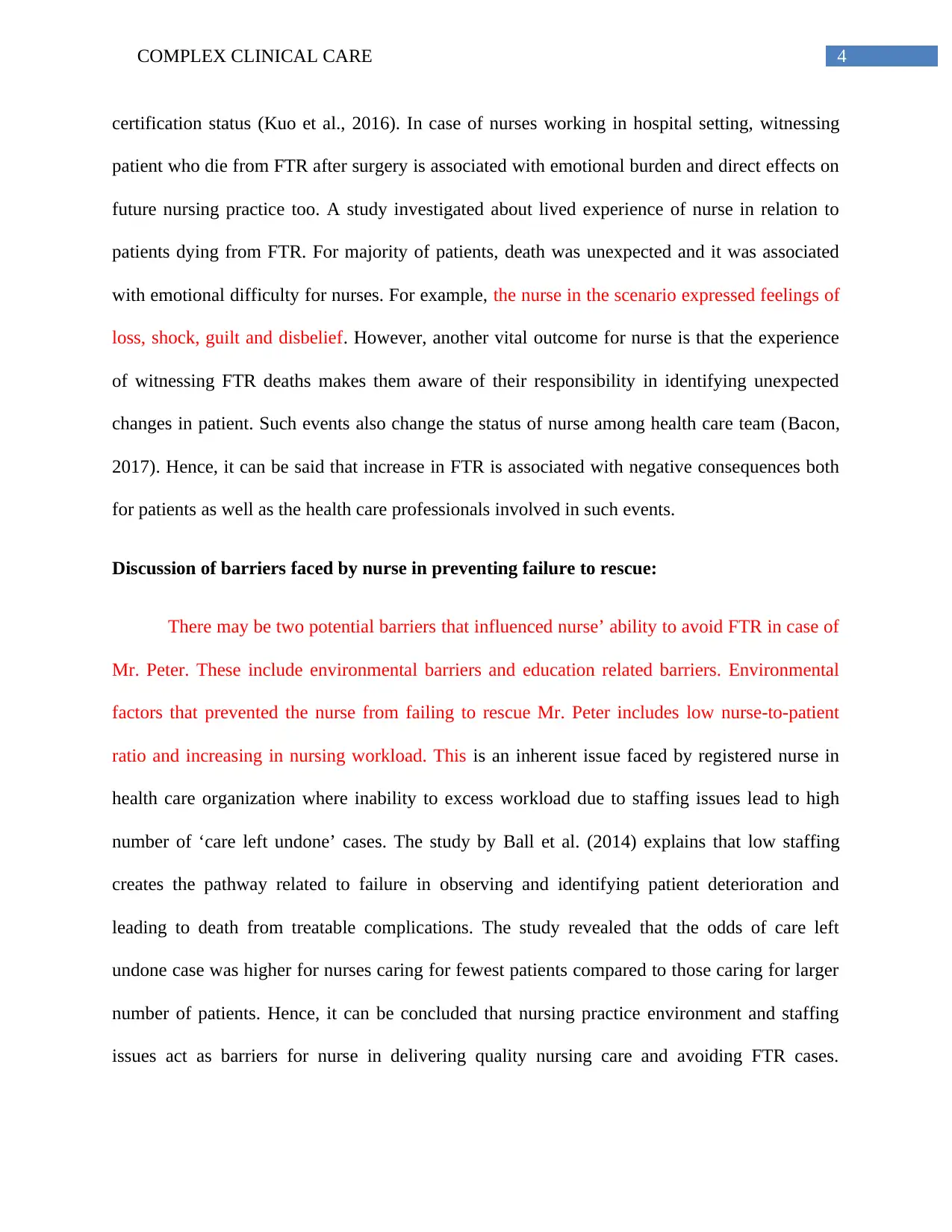
4COMPLEX CLINICAL CARE
certification status (Kuo et al., 2016). In case of nurses working in hospital setting, witnessing
patient who die from FTR after surgery is associated with emotional burden and direct effects on
future nursing practice too. A study investigated about lived experience of nurse in relation to
patients dying from FTR. For majority of patients, death was unexpected and it was associated
with emotional difficulty for nurses. For example, the nurse in the scenario expressed feelings of
loss, shock, guilt and disbelief. However, another vital outcome for nurse is that the experience
of witnessing FTR deaths makes them aware of their responsibility in identifying unexpected
changes in patient. Such events also change the status of nurse among health care team (Bacon,
2017). Hence, it can be said that increase in FTR is associated with negative consequences both
for patients as well as the health care professionals involved in such events.
Discussion of barriers faced by nurse in preventing failure to rescue:
There may be two potential barriers that influenced nurse’ ability to avoid FTR in case of
Mr. Peter. These include environmental barriers and education related barriers. Environmental
factors that prevented the nurse from failing to rescue Mr. Peter includes low nurse-to-patient
ratio and increasing in nursing workload. This is an inherent issue faced by registered nurse in
health care organization where inability to excess workload due to staffing issues lead to high
number of ‘care left undone’ cases. The study by Ball et al. (2014) explains that low staffing
creates the pathway related to failure in observing and identifying patient deterioration and
leading to death from treatable complications. The study revealed that the odds of care left
undone case was higher for nurses caring for fewest patients compared to those caring for larger
number of patients. Hence, it can be concluded that nursing practice environment and staffing
issues act as barriers for nurse in delivering quality nursing care and avoiding FTR cases.
certification status (Kuo et al., 2016). In case of nurses working in hospital setting, witnessing
patient who die from FTR after surgery is associated with emotional burden and direct effects on
future nursing practice too. A study investigated about lived experience of nurse in relation to
patients dying from FTR. For majority of patients, death was unexpected and it was associated
with emotional difficulty for nurses. For example, the nurse in the scenario expressed feelings of
loss, shock, guilt and disbelief. However, another vital outcome for nurse is that the experience
of witnessing FTR deaths makes them aware of their responsibility in identifying unexpected
changes in patient. Such events also change the status of nurse among health care team (Bacon,
2017). Hence, it can be said that increase in FTR is associated with negative consequences both
for patients as well as the health care professionals involved in such events.
Discussion of barriers faced by nurse in preventing failure to rescue:
There may be two potential barriers that influenced nurse’ ability to avoid FTR in case of
Mr. Peter. These include environmental barriers and education related barriers. Environmental
factors that prevented the nurse from failing to rescue Mr. Peter includes low nurse-to-patient
ratio and increasing in nursing workload. This is an inherent issue faced by registered nurse in
health care organization where inability to excess workload due to staffing issues lead to high
number of ‘care left undone’ cases. The study by Ball et al. (2014) explains that low staffing
creates the pathway related to failure in observing and identifying patient deterioration and
leading to death from treatable complications. The study revealed that the odds of care left
undone case was higher for nurses caring for fewest patients compared to those caring for larger
number of patients. Hence, it can be concluded that nursing practice environment and staffing
issues act as barriers for nurse in delivering quality nursing care and avoiding FTR cases.
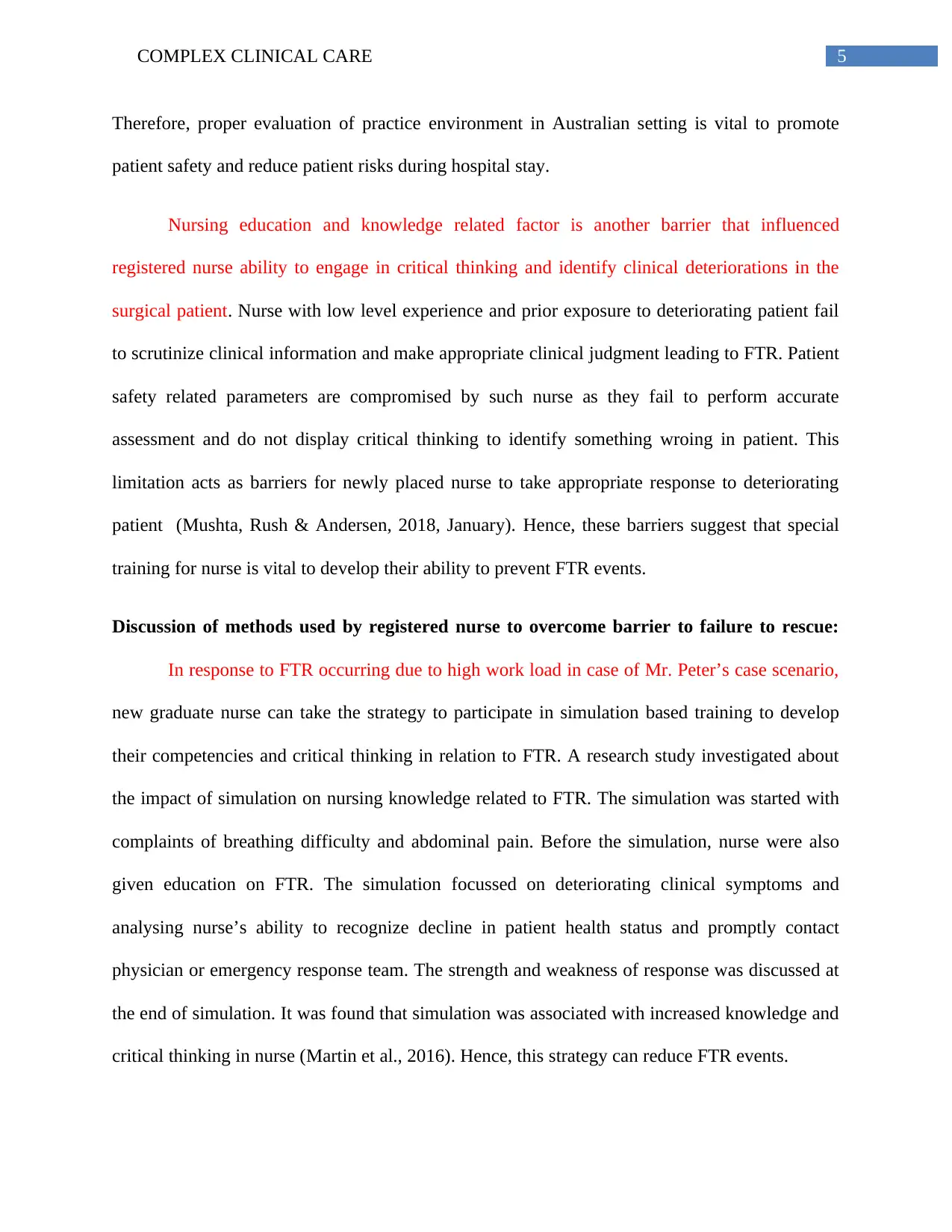
5COMPLEX CLINICAL CARE
Therefore, proper evaluation of practice environment in Australian setting is vital to promote
patient safety and reduce patient risks during hospital stay.
Nursing education and knowledge related factor is another barrier that influenced
registered nurse ability to engage in critical thinking and identify clinical deteriorations in the
surgical patient. Nurse with low level experience and prior exposure to deteriorating patient fail
to scrutinize clinical information and make appropriate clinical judgment leading to FTR. Patient
safety related parameters are compromised by such nurse as they fail to perform accurate
assessment and do not display critical thinking to identify something wroing in patient. This
limitation acts as barriers for newly placed nurse to take appropriate response to deteriorating
patient (Mushta, Rush & Andersen, 2018, January). Hence, these barriers suggest that special
training for nurse is vital to develop their ability to prevent FTR events.
Discussion of methods used by registered nurse to overcome barrier to failure to rescue:
In response to FTR occurring due to high work load in case of Mr. Peter’s case scenario,
new graduate nurse can take the strategy to participate in simulation based training to develop
their competencies and critical thinking in relation to FTR. A research study investigated about
the impact of simulation on nursing knowledge related to FTR. The simulation was started with
complaints of breathing difficulty and abdominal pain. Before the simulation, nurse were also
given education on FTR. The simulation focussed on deteriorating clinical symptoms and
analysing nurse’s ability to recognize decline in patient health status and promptly contact
physician or emergency response team. The strength and weakness of response was discussed at
the end of simulation. It was found that simulation was associated with increased knowledge and
critical thinking in nurse (Martin et al., 2016). Hence, this strategy can reduce FTR events.
Therefore, proper evaluation of practice environment in Australian setting is vital to promote
patient safety and reduce patient risks during hospital stay.
Nursing education and knowledge related factor is another barrier that influenced
registered nurse ability to engage in critical thinking and identify clinical deteriorations in the
surgical patient. Nurse with low level experience and prior exposure to deteriorating patient fail
to scrutinize clinical information and make appropriate clinical judgment leading to FTR. Patient
safety related parameters are compromised by such nurse as they fail to perform accurate
assessment and do not display critical thinking to identify something wroing in patient. This
limitation acts as barriers for newly placed nurse to take appropriate response to deteriorating
patient (Mushta, Rush & Andersen, 2018, January). Hence, these barriers suggest that special
training for nurse is vital to develop their ability to prevent FTR events.
Discussion of methods used by registered nurse to overcome barrier to failure to rescue:
In response to FTR occurring due to high work load in case of Mr. Peter’s case scenario,
new graduate nurse can take the strategy to participate in simulation based training to develop
their competencies and critical thinking in relation to FTR. A research study investigated about
the impact of simulation on nursing knowledge related to FTR. The simulation was started with
complaints of breathing difficulty and abdominal pain. Before the simulation, nurse were also
given education on FTR. The simulation focussed on deteriorating clinical symptoms and
analysing nurse’s ability to recognize decline in patient health status and promptly contact
physician or emergency response team. The strength and weakness of response was discussed at
the end of simulation. It was found that simulation was associated with increased knowledge and
critical thinking in nurse (Martin et al., 2016). Hence, this strategy can reduce FTR events.
⊘ This is a preview!⊘
Do you want full access?
Subscribe today to unlock all pages.

Trusted by 1+ million students worldwide
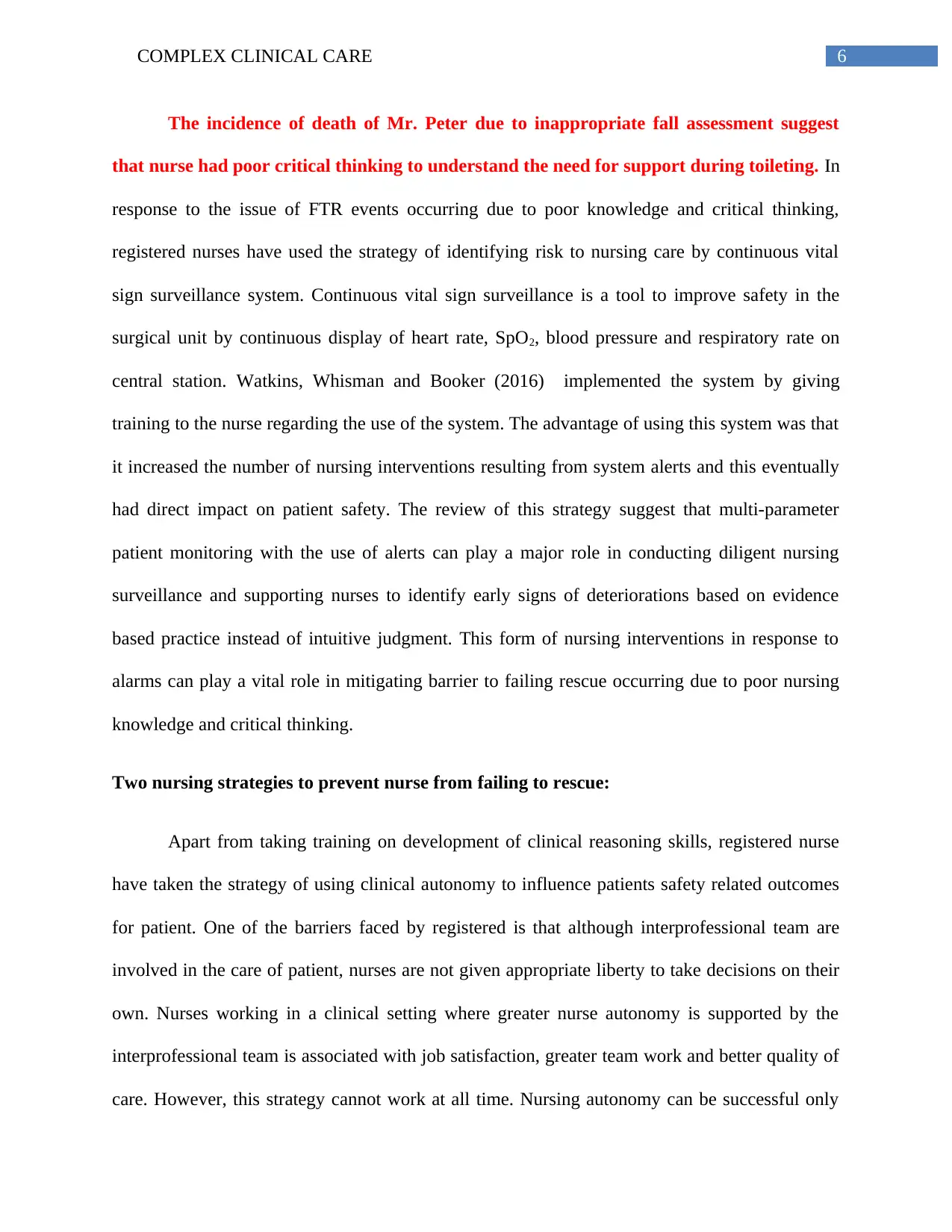
6COMPLEX CLINICAL CARE
The incidence of death of Mr. Peter due to inappropriate fall assessment suggest
that nurse had poor critical thinking to understand the need for support during toileting. In
response to the issue of FTR events occurring due to poor knowledge and critical thinking,
registered nurses have used the strategy of identifying risk to nursing care by continuous vital
sign surveillance system. Continuous vital sign surveillance is a tool to improve safety in the
surgical unit by continuous display of heart rate, SpO2, blood pressure and respiratory rate on
central station. Watkins, Whisman and Booker (2016) implemented the system by giving
training to the nurse regarding the use of the system. The advantage of using this system was that
it increased the number of nursing interventions resulting from system alerts and this eventually
had direct impact on patient safety. The review of this strategy suggest that multi-parameter
patient monitoring with the use of alerts can play a major role in conducting diligent nursing
surveillance and supporting nurses to identify early signs of deteriorations based on evidence
based practice instead of intuitive judgment. This form of nursing interventions in response to
alarms can play a vital role in mitigating barrier to failing rescue occurring due to poor nursing
knowledge and critical thinking.
Two nursing strategies to prevent nurse from failing to rescue:
Apart from taking training on development of clinical reasoning skills, registered nurse
have taken the strategy of using clinical autonomy to influence patients safety related outcomes
for patient. One of the barriers faced by registered is that although interprofessional team are
involved in the care of patient, nurses are not given appropriate liberty to take decisions on their
own. Nurses working in a clinical setting where greater nurse autonomy is supported by the
interprofessional team is associated with job satisfaction, greater team work and better quality of
care. However, this strategy cannot work at all time. Nursing autonomy can be successful only
The incidence of death of Mr. Peter due to inappropriate fall assessment suggest
that nurse had poor critical thinking to understand the need for support during toileting. In
response to the issue of FTR events occurring due to poor knowledge and critical thinking,
registered nurses have used the strategy of identifying risk to nursing care by continuous vital
sign surveillance system. Continuous vital sign surveillance is a tool to improve safety in the
surgical unit by continuous display of heart rate, SpO2, blood pressure and respiratory rate on
central station. Watkins, Whisman and Booker (2016) implemented the system by giving
training to the nurse regarding the use of the system. The advantage of using this system was that
it increased the number of nursing interventions resulting from system alerts and this eventually
had direct impact on patient safety. The review of this strategy suggest that multi-parameter
patient monitoring with the use of alerts can play a major role in conducting diligent nursing
surveillance and supporting nurses to identify early signs of deteriorations based on evidence
based practice instead of intuitive judgment. This form of nursing interventions in response to
alarms can play a vital role in mitigating barrier to failing rescue occurring due to poor nursing
knowledge and critical thinking.
Two nursing strategies to prevent nurse from failing to rescue:
Apart from taking training on development of clinical reasoning skills, registered nurse
have taken the strategy of using clinical autonomy to influence patients safety related outcomes
for patient. One of the barriers faced by registered is that although interprofessional team are
involved in the care of patient, nurses are not given appropriate liberty to take decisions on their
own. Nurses working in a clinical setting where greater nurse autonomy is supported by the
interprofessional team is associated with job satisfaction, greater team work and better quality of
care. However, this strategy cannot work at all time. Nursing autonomy can be successful only
Paraphrase This Document
Need a fresh take? Get an instant paraphrase of this document with our AI Paraphraser
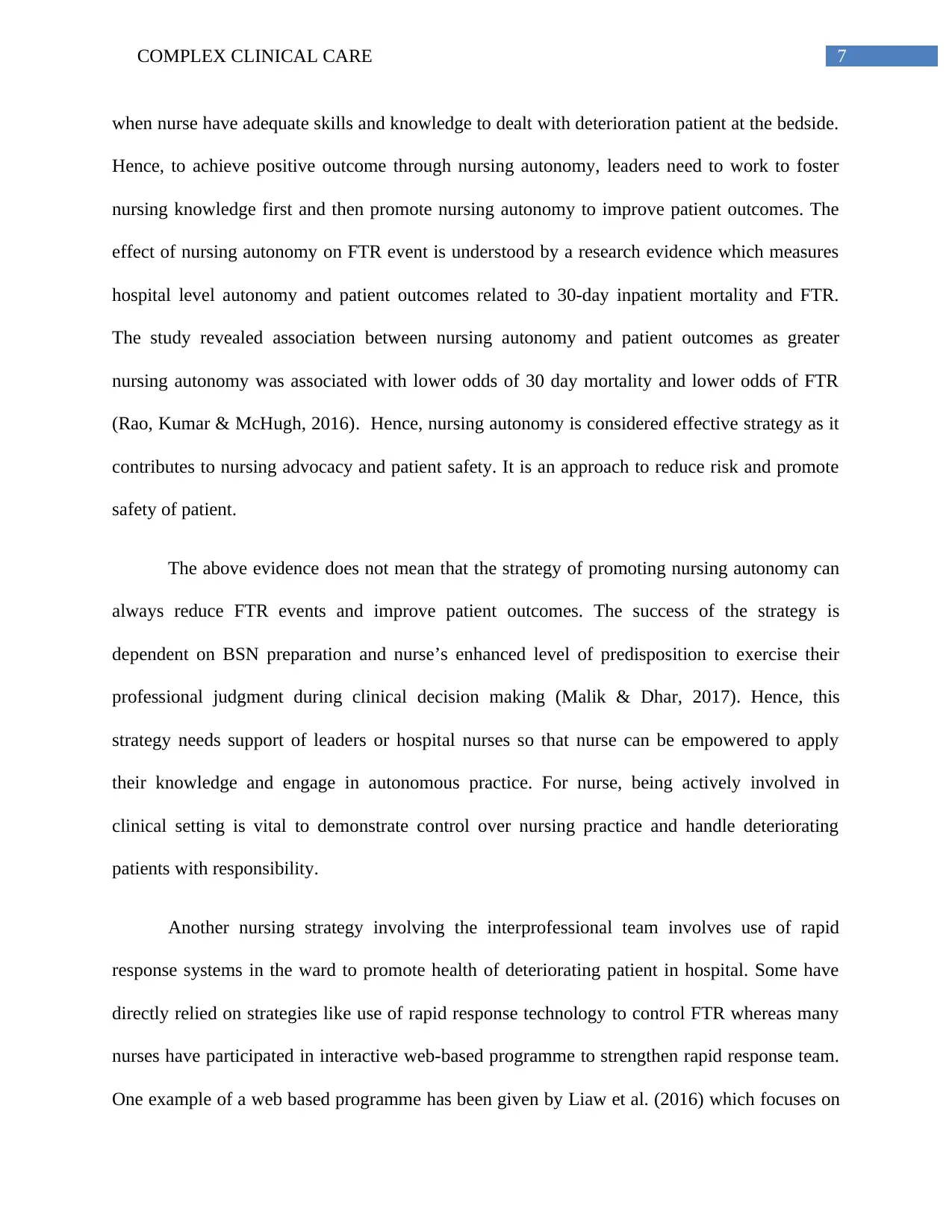
7COMPLEX CLINICAL CARE
when nurse have adequate skills and knowledge to dealt with deterioration patient at the bedside.
Hence, to achieve positive outcome through nursing autonomy, leaders need to work to foster
nursing knowledge first and then promote nursing autonomy to improve patient outcomes. The
effect of nursing autonomy on FTR event is understood by a research evidence which measures
hospital level autonomy and patient outcomes related to 30-day inpatient mortality and FTR.
The study revealed association between nursing autonomy and patient outcomes as greater
nursing autonomy was associated with lower odds of 30 day mortality and lower odds of FTR
(Rao, Kumar & McHugh, 2016). Hence, nursing autonomy is considered effective strategy as it
contributes to nursing advocacy and patient safety. It is an approach to reduce risk and promote
safety of patient.
The above evidence does not mean that the strategy of promoting nursing autonomy can
always reduce FTR events and improve patient outcomes. The success of the strategy is
dependent on BSN preparation and nurse’s enhanced level of predisposition to exercise their
professional judgment during clinical decision making (Malik & Dhar, 2017). Hence, this
strategy needs support of leaders or hospital nurses so that nurse can be empowered to apply
their knowledge and engage in autonomous practice. For nurse, being actively involved in
clinical setting is vital to demonstrate control over nursing practice and handle deteriorating
patients with responsibility.
Another nursing strategy involving the interprofessional team involves use of rapid
response systems in the ward to promote health of deteriorating patient in hospital. Some have
directly relied on strategies like use of rapid response technology to control FTR whereas many
nurses have participated in interactive web-based programme to strengthen rapid response team.
One example of a web based programme has been given by Liaw et al. (2016) which focuses on
when nurse have adequate skills and knowledge to dealt with deterioration patient at the bedside.
Hence, to achieve positive outcome through nursing autonomy, leaders need to work to foster
nursing knowledge first and then promote nursing autonomy to improve patient outcomes. The
effect of nursing autonomy on FTR event is understood by a research evidence which measures
hospital level autonomy and patient outcomes related to 30-day inpatient mortality and FTR.
The study revealed association between nursing autonomy and patient outcomes as greater
nursing autonomy was associated with lower odds of 30 day mortality and lower odds of FTR
(Rao, Kumar & McHugh, 2016). Hence, nursing autonomy is considered effective strategy as it
contributes to nursing advocacy and patient safety. It is an approach to reduce risk and promote
safety of patient.
The above evidence does not mean that the strategy of promoting nursing autonomy can
always reduce FTR events and improve patient outcomes. The success of the strategy is
dependent on BSN preparation and nurse’s enhanced level of predisposition to exercise their
professional judgment during clinical decision making (Malik & Dhar, 2017). Hence, this
strategy needs support of leaders or hospital nurses so that nurse can be empowered to apply
their knowledge and engage in autonomous practice. For nurse, being actively involved in
clinical setting is vital to demonstrate control over nursing practice and handle deteriorating
patients with responsibility.
Another nursing strategy involving the interprofessional team involves use of rapid
response systems in the ward to promote health of deteriorating patient in hospital. Some have
directly relied on strategies like use of rapid response technology to control FTR whereas many
nurses have participated in interactive web-based programme to strengthen rapid response team.
One example of a web based programme has been given by Liaw et al. (2016) which focuses on
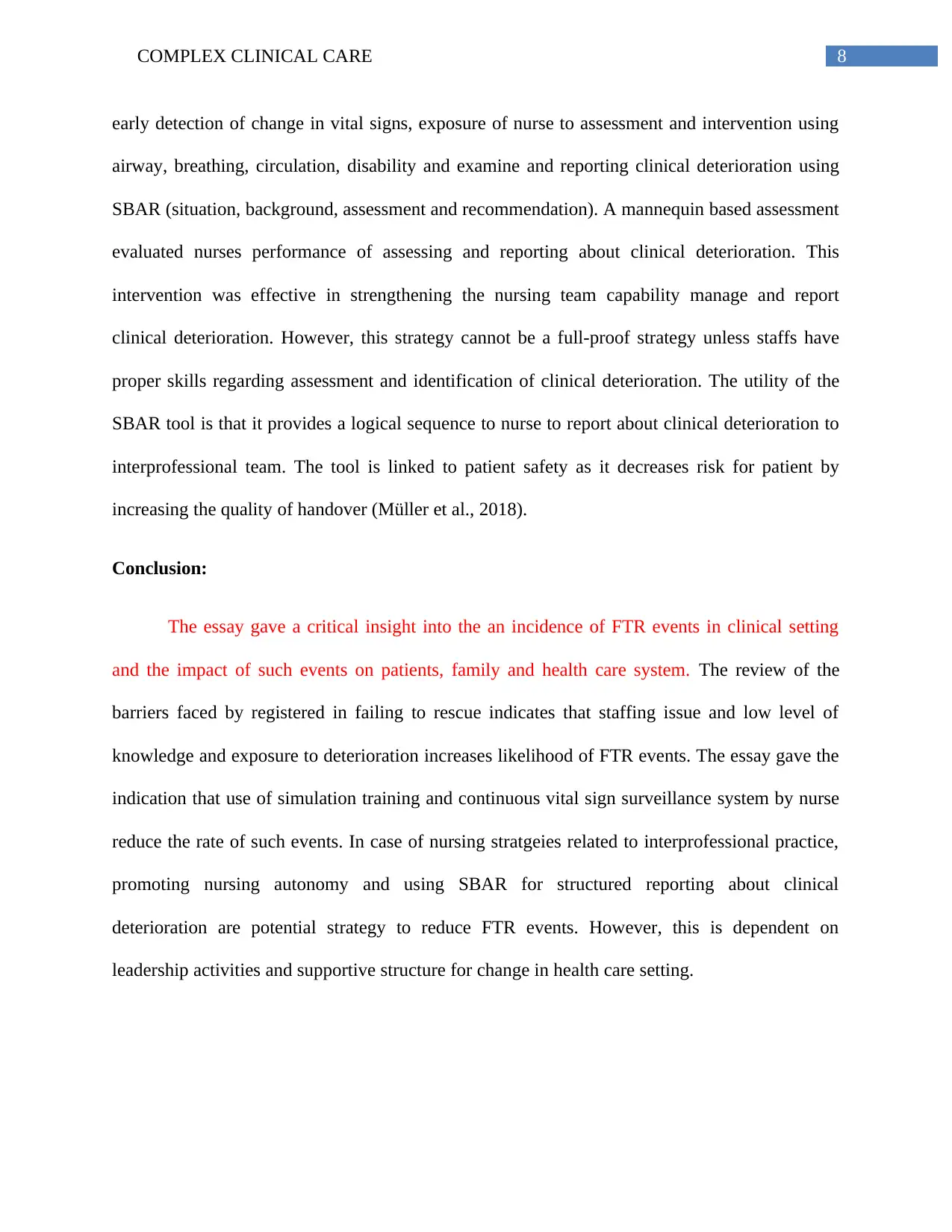
8COMPLEX CLINICAL CARE
early detection of change in vital signs, exposure of nurse to assessment and intervention using
airway, breathing, circulation, disability and examine and reporting clinical deterioration using
SBAR (situation, background, assessment and recommendation). A mannequin based assessment
evaluated nurses performance of assessing and reporting about clinical deterioration. This
intervention was effective in strengthening the nursing team capability manage and report
clinical deterioration. However, this strategy cannot be a full-proof strategy unless staffs have
proper skills regarding assessment and identification of clinical deterioration. The utility of the
SBAR tool is that it provides a logical sequence to nurse to report about clinical deterioration to
interprofessional team. The tool is linked to patient safety as it decreases risk for patient by
increasing the quality of handover (Müller et al., 2018).
Conclusion:
The essay gave a critical insight into the an incidence of FTR events in clinical setting
and the impact of such events on patients, family and health care system. The review of the
barriers faced by registered in failing to rescue indicates that staffing issue and low level of
knowledge and exposure to deterioration increases likelihood of FTR events. The essay gave the
indication that use of simulation training and continuous vital sign surveillance system by nurse
reduce the rate of such events. In case of nursing stratgeies related to interprofessional practice,
promoting nursing autonomy and using SBAR for structured reporting about clinical
deterioration are potential strategy to reduce FTR events. However, this is dependent on
leadership activities and supportive structure for change in health care setting.
early detection of change in vital signs, exposure of nurse to assessment and intervention using
airway, breathing, circulation, disability and examine and reporting clinical deterioration using
SBAR (situation, background, assessment and recommendation). A mannequin based assessment
evaluated nurses performance of assessing and reporting about clinical deterioration. This
intervention was effective in strengthening the nursing team capability manage and report
clinical deterioration. However, this strategy cannot be a full-proof strategy unless staffs have
proper skills regarding assessment and identification of clinical deterioration. The utility of the
SBAR tool is that it provides a logical sequence to nurse to report about clinical deterioration to
interprofessional team. The tool is linked to patient safety as it decreases risk for patient by
increasing the quality of handover (Müller et al., 2018).
Conclusion:
The essay gave a critical insight into the an incidence of FTR events in clinical setting
and the impact of such events on patients, family and health care system. The review of the
barriers faced by registered in failing to rescue indicates that staffing issue and low level of
knowledge and exposure to deterioration increases likelihood of FTR events. The essay gave the
indication that use of simulation training and continuous vital sign surveillance system by nurse
reduce the rate of such events. In case of nursing stratgeies related to interprofessional practice,
promoting nursing autonomy and using SBAR for structured reporting about clinical
deterioration are potential strategy to reduce FTR events. However, this is dependent on
leadership activities and supportive structure for change in health care setting.
⊘ This is a preview!⊘
Do you want full access?
Subscribe today to unlock all pages.

Trusted by 1+ million students worldwide
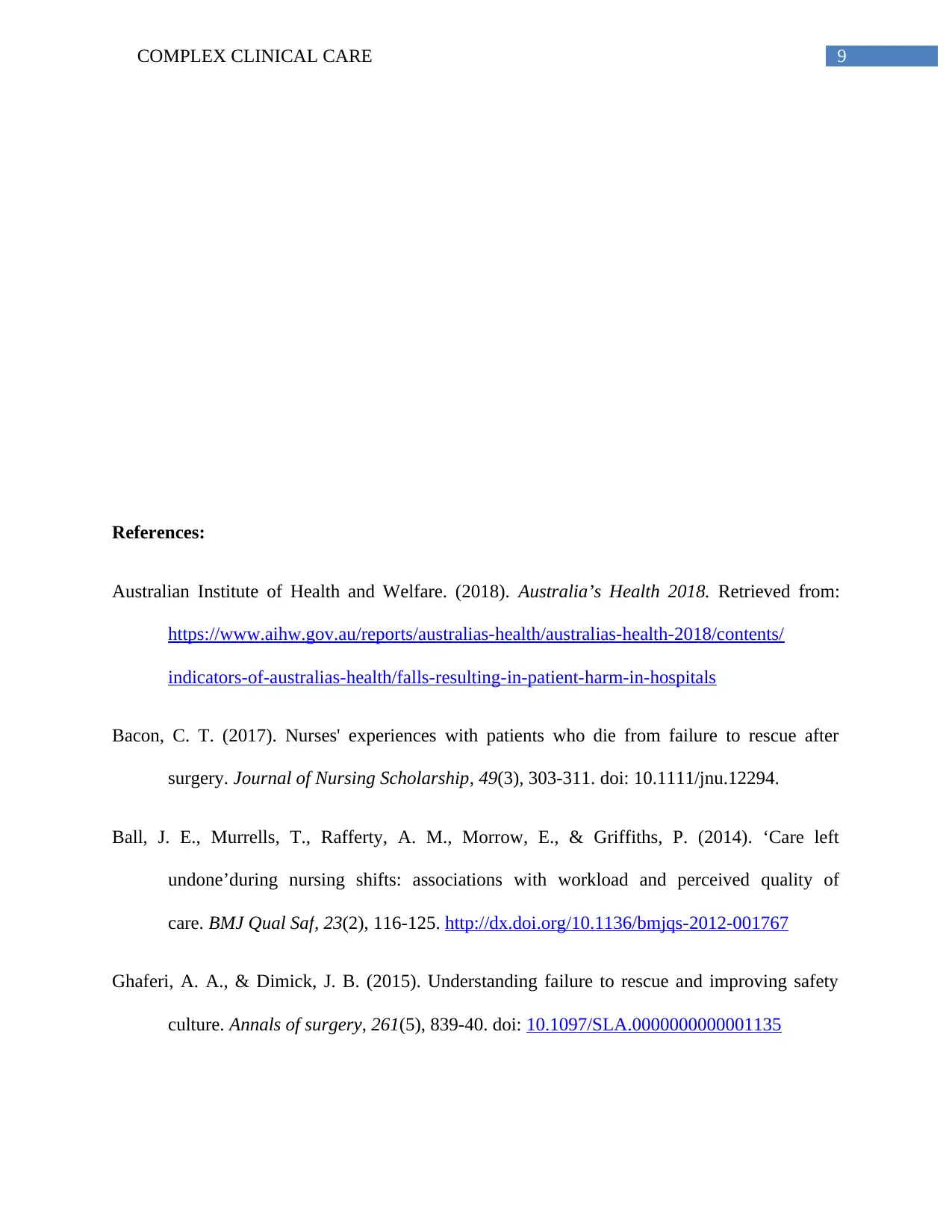
9COMPLEX CLINICAL CARE
References:
Australian Institute of Health and Welfare. (2018). Australia’s Health 2018. Retrieved from:
https://www.aihw.gov.au/reports/australias-health/australias-health-2018/contents/
indicators-of-australias-health/falls-resulting-in-patient-harm-in-hospitals
Bacon, C. T. (2017). Nurses' experiences with patients who die from failure to rescue after
surgery. Journal of Nursing Scholarship, 49(3), 303-311. doi: 10.1111/jnu.12294.
Ball, J. E., Murrells, T., Rafferty, A. M., Morrow, E., & Griffiths, P. (2014). ‘Care left
undone’during nursing shifts: associations with workload and perceived quality of
care. BMJ Qual Saf, 23(2), 116-125. http://dx.doi.org/10.1136/bmjqs-2012-001767
Ghaferi, A. A., & Dimick, J. B. (2015). Understanding failure to rescue and improving safety
culture. Annals of surgery, 261(5), 839-40. doi: 10.1097/SLA.0000000000001135
References:
Australian Institute of Health and Welfare. (2018). Australia’s Health 2018. Retrieved from:
https://www.aihw.gov.au/reports/australias-health/australias-health-2018/contents/
indicators-of-australias-health/falls-resulting-in-patient-harm-in-hospitals
Bacon, C. T. (2017). Nurses' experiences with patients who die from failure to rescue after
surgery. Journal of Nursing Scholarship, 49(3), 303-311. doi: 10.1111/jnu.12294.
Ball, J. E., Murrells, T., Rafferty, A. M., Morrow, E., & Griffiths, P. (2014). ‘Care left
undone’during nursing shifts: associations with workload and perceived quality of
care. BMJ Qual Saf, 23(2), 116-125. http://dx.doi.org/10.1136/bmjqs-2012-001767
Ghaferi, A. A., & Dimick, J. B. (2015). Understanding failure to rescue and improving safety
culture. Annals of surgery, 261(5), 839-40. doi: 10.1097/SLA.0000000000001135
Paraphrase This Document
Need a fresh take? Get an instant paraphrase of this document with our AI Paraphraser
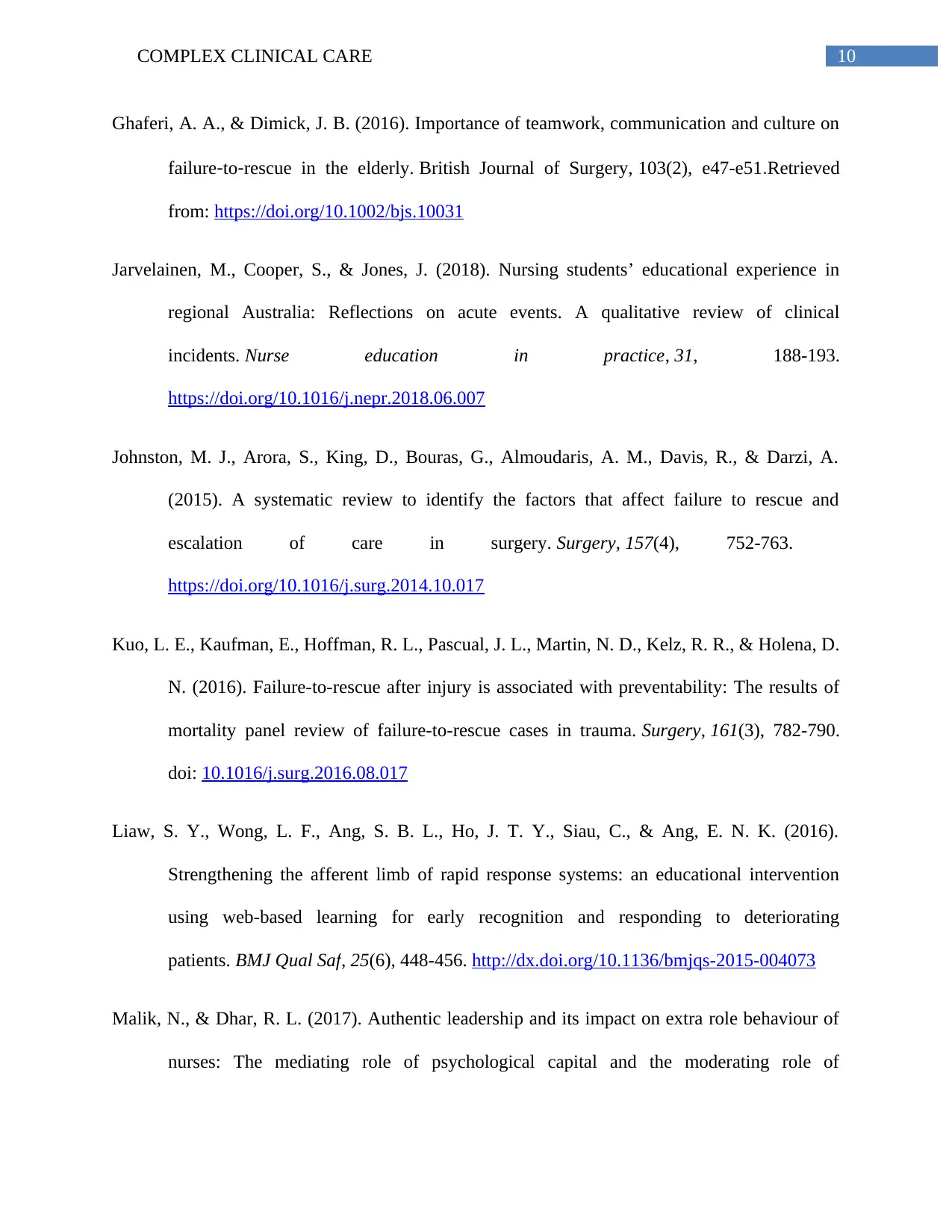
10COMPLEX CLINICAL CARE
Ghaferi, A. A., & Dimick, J. B. (2016). Importance of teamwork, communication and culture on
failure‐to‐rescue in the elderly. British Journal of Surgery, 103(2), e47-e51.Retrieved
from: https://doi.org/10.1002/bjs.10031
Jarvelainen, M., Cooper, S., & Jones, J. (2018). Nursing students’ educational experience in
regional Australia: Reflections on acute events. A qualitative review of clinical
incidents. Nurse education in practice, 31, 188-193.
https://doi.org/10.1016/j.nepr.2018.06.007
Johnston, M. J., Arora, S., King, D., Bouras, G., Almoudaris, A. M., Davis, R., & Darzi, A.
(2015). A systematic review to identify the factors that affect failure to rescue and
escalation of care in surgery. Surgery, 157(4), 752-763.
https://doi.org/10.1016/j.surg.2014.10.017
Kuo, L. E., Kaufman, E., Hoffman, R. L., Pascual, J. L., Martin, N. D., Kelz, R. R., & Holena, D.
N. (2016). Failure-to-rescue after injury is associated with preventability: The results of
mortality panel review of failure-to-rescue cases in trauma. Surgery, 161(3), 782-790.
doi: 10.1016/j.surg.2016.08.017
Liaw, S. Y., Wong, L. F., Ang, S. B. L., Ho, J. T. Y., Siau, C., & Ang, E. N. K. (2016).
Strengthening the afferent limb of rapid response systems: an educational intervention
using web-based learning for early recognition and responding to deteriorating
patients. BMJ Qual Saf, 25(6), 448-456. http://dx.doi.org/10.1136/bmjqs-2015-004073
Malik, N., & Dhar, R. L. (2017). Authentic leadership and its impact on extra role behaviour of
nurses: The mediating role of psychological capital and the moderating role of
Ghaferi, A. A., & Dimick, J. B. (2016). Importance of teamwork, communication and culture on
failure‐to‐rescue in the elderly. British Journal of Surgery, 103(2), e47-e51.Retrieved
from: https://doi.org/10.1002/bjs.10031
Jarvelainen, M., Cooper, S., & Jones, J. (2018). Nursing students’ educational experience in
regional Australia: Reflections on acute events. A qualitative review of clinical
incidents. Nurse education in practice, 31, 188-193.
https://doi.org/10.1016/j.nepr.2018.06.007
Johnston, M. J., Arora, S., King, D., Bouras, G., Almoudaris, A. M., Davis, R., & Darzi, A.
(2015). A systematic review to identify the factors that affect failure to rescue and
escalation of care in surgery. Surgery, 157(4), 752-763.
https://doi.org/10.1016/j.surg.2014.10.017
Kuo, L. E., Kaufman, E., Hoffman, R. L., Pascual, J. L., Martin, N. D., Kelz, R. R., & Holena, D.
N. (2016). Failure-to-rescue after injury is associated with preventability: The results of
mortality panel review of failure-to-rescue cases in trauma. Surgery, 161(3), 782-790.
doi: 10.1016/j.surg.2016.08.017
Liaw, S. Y., Wong, L. F., Ang, S. B. L., Ho, J. T. Y., Siau, C., & Ang, E. N. K. (2016).
Strengthening the afferent limb of rapid response systems: an educational intervention
using web-based learning for early recognition and responding to deteriorating
patients. BMJ Qual Saf, 25(6), 448-456. http://dx.doi.org/10.1136/bmjqs-2015-004073
Malik, N., & Dhar, R. L. (2017). Authentic leadership and its impact on extra role behaviour of
nurses: The mediating role of psychological capital and the moderating role of
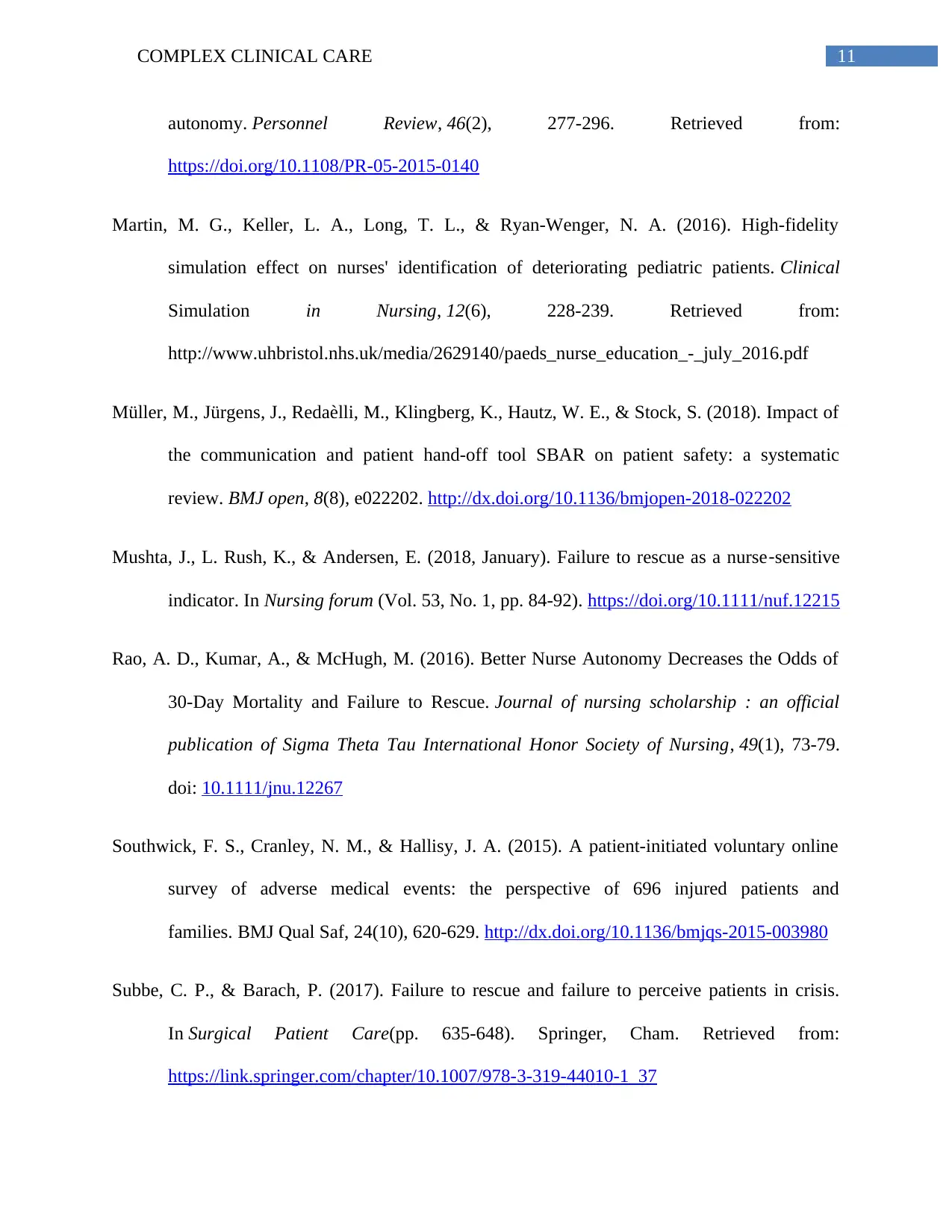
11COMPLEX CLINICAL CARE
autonomy. Personnel Review, 46(2), 277-296. Retrieved from:
https://doi.org/10.1108/PR-05-2015-0140
Martin, M. G., Keller, L. A., Long, T. L., & Ryan-Wenger, N. A. (2016). High-fidelity
simulation effect on nurses' identification of deteriorating pediatric patients. Clinical
Simulation in Nursing, 12(6), 228-239. Retrieved from:
http://www.uhbristol.nhs.uk/media/2629140/paeds_nurse_education_-_july_2016.pdf
Müller, M., Jürgens, J., Redaèlli, M., Klingberg, K., Hautz, W. E., & Stock, S. (2018). Impact of
the communication and patient hand-off tool SBAR on patient safety: a systematic
review. BMJ open, 8(8), e022202. http://dx.doi.org/10.1136/bmjopen-2018-022202
Mushta, J., L. Rush, K., & Andersen, E. (2018, January). Failure to rescue as a nurse‐sensitive
indicator. In Nursing forum (Vol. 53, No. 1, pp. 84-92). https://doi.org/10.1111/nuf.12215
Rao, A. D., Kumar, A., & McHugh, M. (2016). Better Nurse Autonomy Decreases the Odds of
30-Day Mortality and Failure to Rescue. Journal of nursing scholarship : an official
publication of Sigma Theta Tau International Honor Society of Nursing, 49(1), 73-79.
doi: 10.1111/jnu.12267
Southwick, F. S., Cranley, N. M., & Hallisy, J. A. (2015). A patient-initiated voluntary online
survey of adverse medical events: the perspective of 696 injured patients and
families. BMJ Qual Saf, 24(10), 620-629. http://dx.doi.org/10.1136/bmjqs-2015-003980
Subbe, C. P., & Barach, P. (2017). Failure to rescue and failure to perceive patients in crisis.
In Surgical Patient Care(pp. 635-648). Springer, Cham. Retrieved from:
https://link.springer.com/chapter/10.1007/978-3-319-44010-1_37
autonomy. Personnel Review, 46(2), 277-296. Retrieved from:
https://doi.org/10.1108/PR-05-2015-0140
Martin, M. G., Keller, L. A., Long, T. L., & Ryan-Wenger, N. A. (2016). High-fidelity
simulation effect on nurses' identification of deteriorating pediatric patients. Clinical
Simulation in Nursing, 12(6), 228-239. Retrieved from:
http://www.uhbristol.nhs.uk/media/2629140/paeds_nurse_education_-_july_2016.pdf
Müller, M., Jürgens, J., Redaèlli, M., Klingberg, K., Hautz, W. E., & Stock, S. (2018). Impact of
the communication and patient hand-off tool SBAR on patient safety: a systematic
review. BMJ open, 8(8), e022202. http://dx.doi.org/10.1136/bmjopen-2018-022202
Mushta, J., L. Rush, K., & Andersen, E. (2018, January). Failure to rescue as a nurse‐sensitive
indicator. In Nursing forum (Vol. 53, No. 1, pp. 84-92). https://doi.org/10.1111/nuf.12215
Rao, A. D., Kumar, A., & McHugh, M. (2016). Better Nurse Autonomy Decreases the Odds of
30-Day Mortality and Failure to Rescue. Journal of nursing scholarship : an official
publication of Sigma Theta Tau International Honor Society of Nursing, 49(1), 73-79.
doi: 10.1111/jnu.12267
Southwick, F. S., Cranley, N. M., & Hallisy, J. A. (2015). A patient-initiated voluntary online
survey of adverse medical events: the perspective of 696 injured patients and
families. BMJ Qual Saf, 24(10), 620-629. http://dx.doi.org/10.1136/bmjqs-2015-003980
Subbe, C. P., & Barach, P. (2017). Failure to rescue and failure to perceive patients in crisis.
In Surgical Patient Care(pp. 635-648). Springer, Cham. Retrieved from:
https://link.springer.com/chapter/10.1007/978-3-319-44010-1_37
⊘ This is a preview!⊘
Do you want full access?
Subscribe today to unlock all pages.

Trusted by 1+ million students worldwide
1 out of 13
Related Documents
Your All-in-One AI-Powered Toolkit for Academic Success.
+13062052269
info@desklib.com
Available 24*7 on WhatsApp / Email
![[object Object]](/_next/static/media/star-bottom.7253800d.svg)
Unlock your academic potential
Copyright © 2020–2025 A2Z Services. All Rights Reserved. Developed and managed by ZUCOL.





